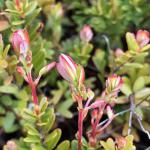Spag (sparganothis fruitworm) is starting to show up. Larvae can be found in loosestrife tips (see photos below, courtesy Marty Sylvia) and cupped cranberry tips. Pheromone traps reportedly already have caught some moths, so once again, it’s a difficult, spread-out population. Intrepid, Invertid, or Delegate now or later are your options.
Weevil continues to have high counts in several hot spots. Many sites have had good luck with Avaunt, Actara or both. This week is truly your last chance for a shot at management. Actara the only real option now. In general, weevil counts are going down – they might be transitioning to summer population.
Many green spanworm have already pupated and management should no longer be considered unless you have a very recent sweep with very high numbers. We expect to see moths flying possibly as soon as next week, especially with the heat predicted this weekend.
Scale spots are being reported and management should NOT be pursued until "crawlers" have been found (unfortunately 10-14 days away). While both bumblebees and honeybees are starting to be delivered late next week, an early shot of Diazinon will not manage scale. Keep in touch with Marty (martys@umass.edu) if you are trying to time a spray for scale.
The search for casebearers has begun. If you are finding tiny beetles in your sweep sets, try to get a sample to Marty at the station to confirm identity. The very small insects in your net could well be harmless mites or collembola (springtails) or they could be leafhopper nymphs or the troublesome beetles. It takes a microscope to tell the difference.
Cranberry vines are moving into pre-bloom, with a few hooks here and there (see photo). Some early blossoms in 2- or 3-year old bogs have been seen.
As you are getting ready for your first fungicide spray, please note that fungicide applications should have good coverage of the canopy and take place before rot fungi infect plant tissues. Most fruit rot infections occur during the bloom (flowering) period and early fruit set, before berries start to size up. Your first application should happen when around 30% flowers are opened (definitely before 50% bloom). Once the fruit has set and begun to increase in size (mid-late July), fungicides are no longer necessary or effective.
If you are considering broad-spectrum fungicides such as Chlorothalonils (eg. Bravo Weather Stik and Bravo Ultrex) and Mancozebs (eg. Manzate Max, Dithane M-45) as part of fungicide regimes, please use them early in “the possible infection period” or “disease development phase” (when the maximum number of flowers are open: Early to mid-bloom). Do not apply more than two applications of Group 3 and Group 11 fungicides (eg. Proline, QuadrisTop, Indar and Abound) due to resistance concerns. Copper fungicides (eg. Kocide 3000, Badge SC, Champ, Mastercop), if chosen, should be applied starting from late bloom.
If you have questions related to the choice of fungicides, frequency, how to count bloom and time fungicides please contact Leela Uppala (suppala@umass.edu or 334-728-1025)


